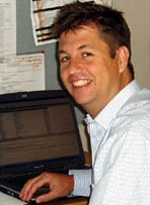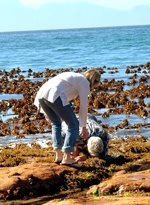SAEON Elwandle Node gears up for action
The month of June saw the establishment of SAEON's Elwandle Node. Node manager Angus Paterson answers some pertinent questions about the new node.
|
Firstly, allow me to introduce myself. My name is Angus Paterson and I am the newly appointed Elwandle node manager. The month of June saw the establishment of SAEON’s Elwandle node, with the first staff member (me) moving into our new offices in Somerset Street, Grahamstown. Since my arrival I have been inundated with questions from the public and the coastal scientific community regarding the new node. Hopefully this short article will update you, SAEON’s stakeholders, on a few of the commonly asked questions about the new node.
Why Grahamstown? While Grahamstown is situated 60km from the sea and thus would not seem to be a logical site for the coastal and inshore node, the South African Institute for Aquatic Biodiversity (SAIAB) is located here and able to provide the right type of scientific, logistical, IT and administrative support for the node.
What is the mandate of the node? The node will fulfil the broader mandate of SAEON, which is to serve as a research and education platform for long-term studies of ecosystems so that we may be able to improve our ability to detect, predict and react to environmental change. The core research programme will strive to distinguish between natural change and that caused by human activity, as well as to unravel the relationship between social change and ecosystem change.
The above will be undertaken within the context of providing the required long-term monitoring needs for the southern African coastline, including rocky shores, beaches, estuaries, shallow reef communities and dune ecosystems.
"The coastal inshore node will also be looking at the coastlines of Southern Ocean islands such as Marion and Gough."
Will the node cover all marine monitoring? The coastal and inshore node does not cover open ocean systems, which will be the mandate of the offshore marine node to be hosted by Marine & Coastal Management (MCM). The coastal inshore node will, however, be looking at the coastlines of Southern Ocean islands such as Marion and Gough.
How will the node interact with existing coastal monitoring programmes? One of the initial tasks will be to interact with the existing SAEON metadata project, which aims to identify existing long-term datasets. In addition, as one of its initial functions, Elwandle will be undertaking a coast-wide audit of current activities and capabilities to ensure that the initial work adds maximum value in terms of plugging existing gaps.
Once existing programmes are identified, Elwandle hopes to form partnerships with the institutions undertaking these programmes so that they can run as effectively and efficiently as possible. Depending on the situation, Elwandle will aim to provide database skills, information archiving, monitoring programme design, logistical support and review activities.
Have you got money for us to do monitoring? One of the most commonly asked questions! Elwandle does have an internal operating budget to cover staff and general running expenses but should not be viewed as a funding or grant agency. SAEON’s mandate is specifically to facilitate and form partnerships with other agencies such as government, NGOs, industry and international funding agencies to promote long-term ecological research.
What staffing will the node have? Initially the node aims to have a manager, education officer and IT/database scientist. After these posts have been filled, it is envisaged that a number of monitoring scientists, postdoctoral and postgraduate students will be working on activities specific to Elwandle, as well as collaborative LTER programmes.
What are the projected milestones? The broad milestones are to have the initial staff complement, steering committee and detailed four-year business/scientific plan in place by November 2006 – so watch this space for details.
I look forward to interacting with the southern African scientific and management communities and specifically the coastal community.












